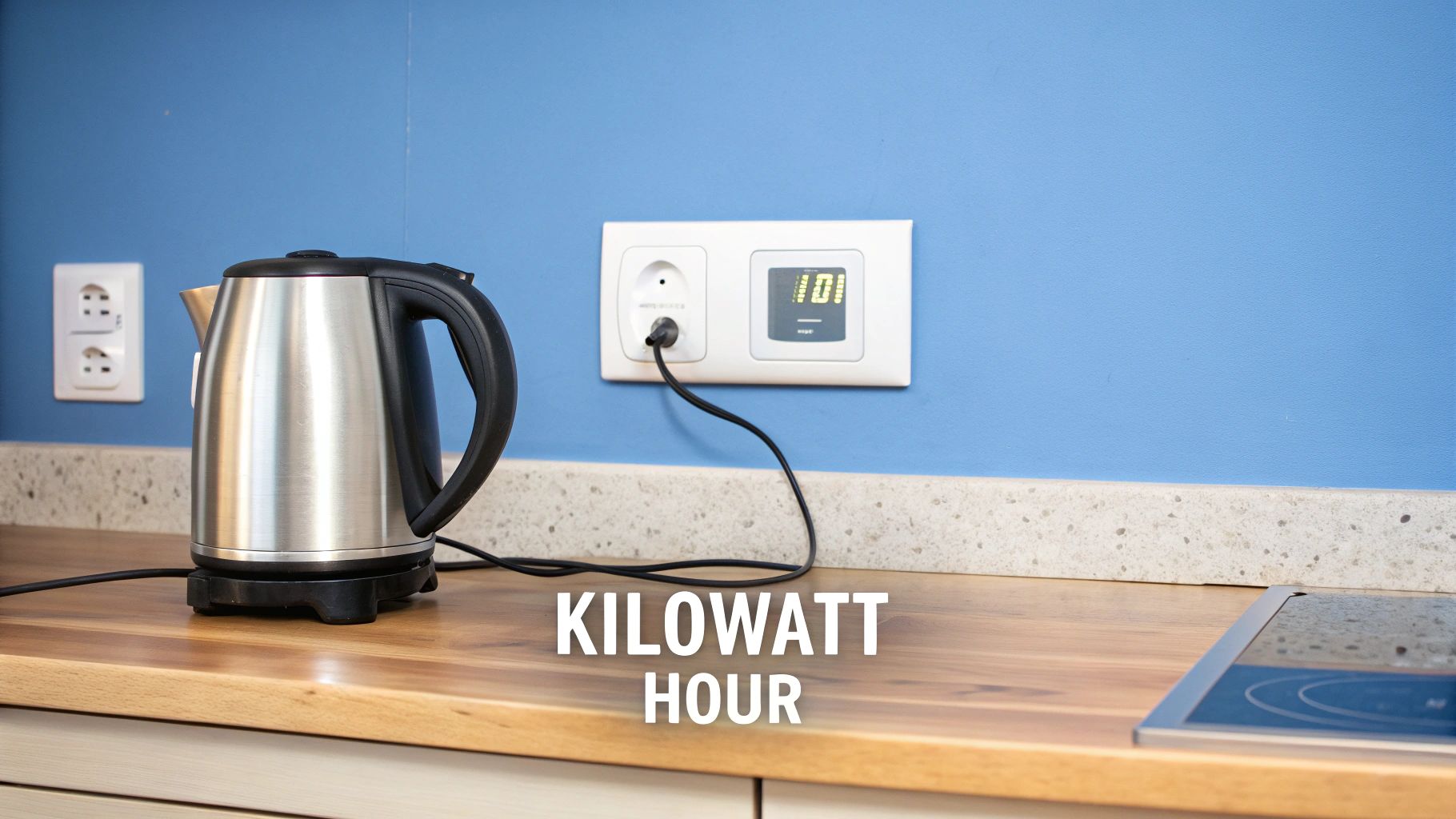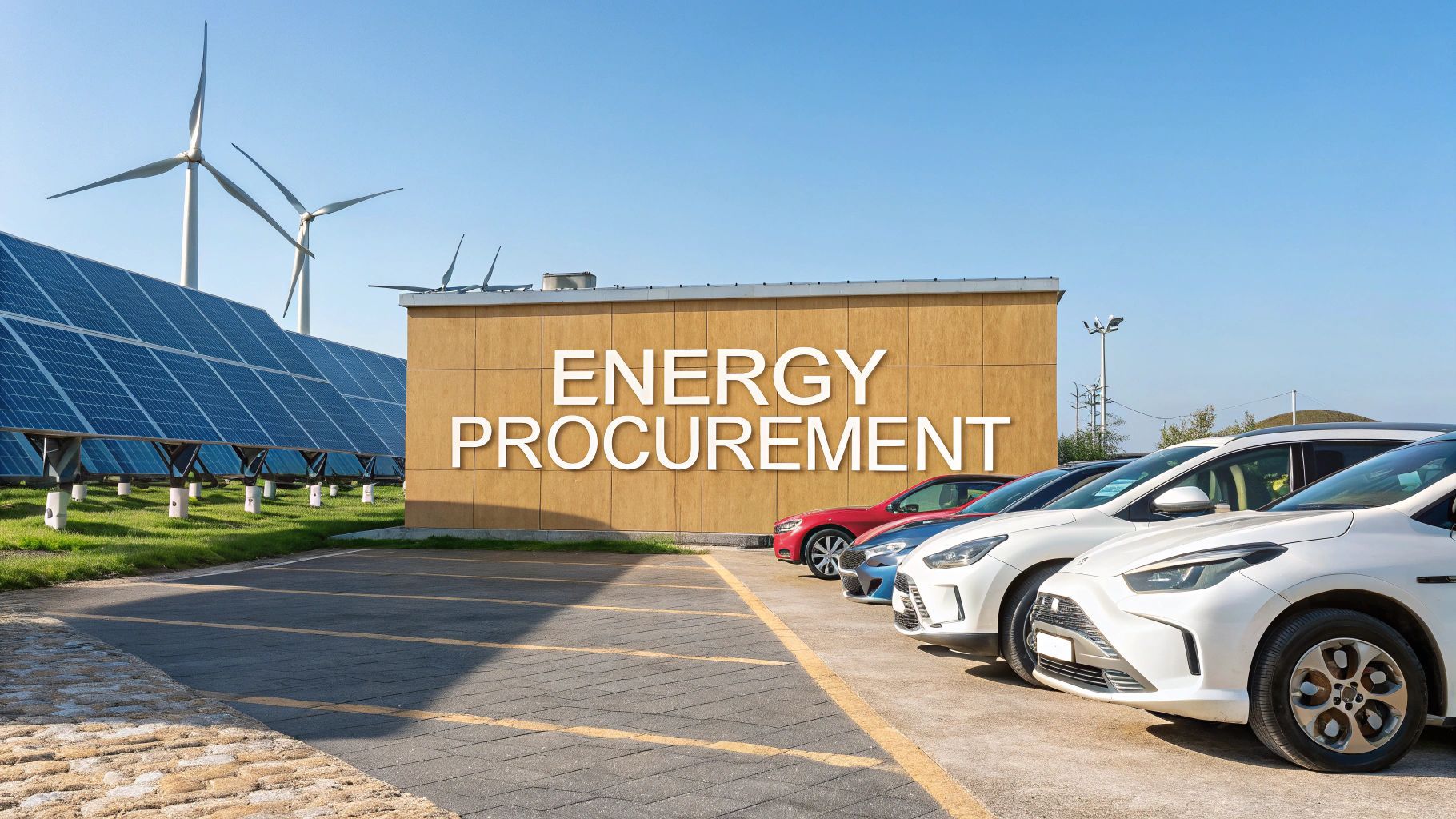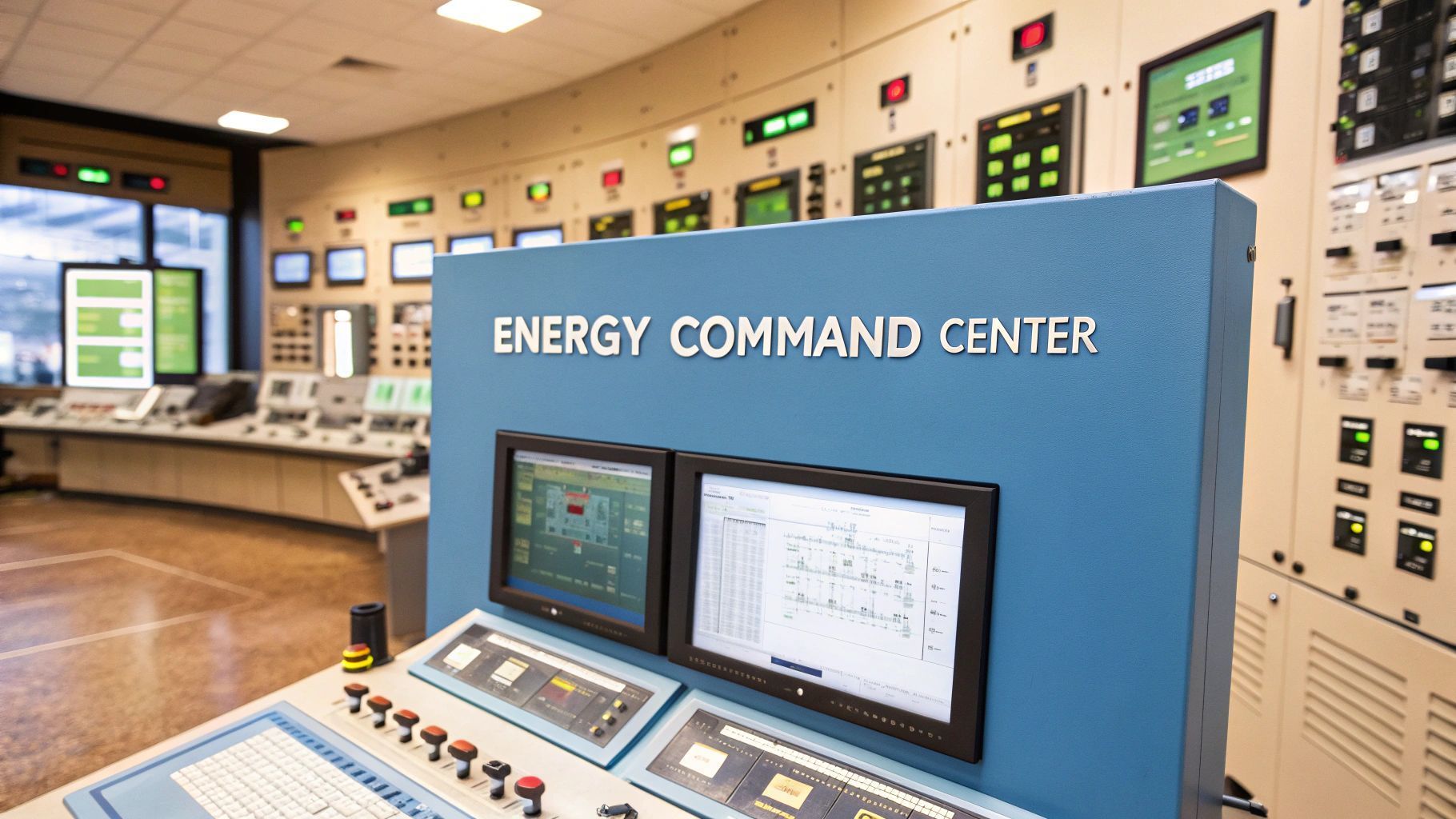EV charging explained: what is a kilowatt-hour?
If you have ever looked at your electricity bill and felt a bit lost, you are not alone. The key to understanding it all lies in one simple unit: the kilowatt-hour (kWh) .
Think of it like this. A kilowatt (kW) measures power —the rate at which energy is used. It is like the speed of water flowing from a tap. But the kilowatt-hour measures energy —the total amount of electricity you have actually used over time. It is the bucket of water you have collected, not how fast the tap was running.
This distinction is everything. Power is the potential but energy is the result.
Your Essential Energy Metric Explained

Getting to grips with the kilowatt-hour is vital in today's world, especially with electric vehicles (EVs) and grid-scale batteries becoming commonplace. It is the unit you are billed for and it dictates the cost of charging your EV or powering your business.
In simple terms, one kWh is the energy a 1,000-watt appliance uses in one hour . This single metric ties directly into the entire energy ecosystem. It tells you how much energy an EV battery can store, how much combined on-site renewables are producing and how much you are pulling from (or selling back to) the grid.
To help clear things up, let's break down the difference between the two terms side-by-side.
Kilowatt vs Kilowatt-Hour at a Glance
| Concept | Kilowatt (kW) | Kilowatt-Hour (kWh) | Simple Analogy |
|---|---|---|---|
| What It Is | A measure of power | A measure of energy | |
| What It Shows | The rate of energy use at a single moment | The total amount of energy used over time | |
| Real-World Use | Describes the power rating of a charger (e.g., a 150 kW rapid EV charger) | Appears on your electricity bill to show consumption | |
| Analogy | Speed (how fast you're driving) | Distance (how far you've travelled) |
Seeing them together makes the distinction much clearer. One is a snapshot of power, the other is the total energy consumed over a period.
Why Kilowatt-Hours Matter Today
Here in the UK, the kWh is the gold standard for billing and measuring electricity. For a bit of perspective, the average UK home gets through about 2,700 kWh of electricity per year . This number is becoming more and more relevant as we all start adopting new energy technologies.
Understanding this concept is the first real step toward taking control of your energy. It lets you:
- Properly calculate EV charging costs and times.
- Choose the right size grid-scale battery system.
- Make sense of the output from on-site renewables.
- Navigate the challenges of a constrained grid connection.
Ultimately, grasping what a kilowatt-hour is gives you the foundation for smart home energy management . It is what allows you to cut costs and get the most out of your energy setup, especially when dealing with EV charging, batteries and distributed energy systems.
From Grid-Scale Batteries to EVs: Making Sense of Your Energy Use
The kilowatt-hour is not just a number tucked away on your electricity bill; it is the real-world yardstick for the energy you use every single day. Getting your head around how to calculate it is the first step towards properly managing your consumption and, more importantly, your costs.
The good news is that the formula is surprisingly straightforward. It works for everything from a single mobile EV charger to a large grid-scale battery installation.
The Core Formula: Power (kW) × Time (hours) = Energy (kWh)
This simple bit of multiplication is all you need. It cuts through the jargon and shows you exactly how much energy any device is pulling from the grid over a set period. Once you grasp this, you can stop seeing abstract figures and start understanding your actual, tangible usage.
From the Grid to the Driveway
Let's scale this up to the main event: charging your electric car.
An EV's battery capacity is measured in kWh—this number tells you how much energy it can hold when it is full. Take a popular EV with a 60 kWh battery. If you are plugging it into a typical 7 kW home charger, you can easily work out how long a full charge from empty will take:
60 kWh (Battery Size) ÷ 7 kW (Charger Power) ≈ 8.5 hours
This is a fundamental calculation for any EV driver. It is what helps you plan overnight charging sessions and gives you a feel for how much faster a public rapid charger will be compared to your setup at home. The same logic applies to mobile EV charging units, where the power rating (kW) determines how quickly it can deliver a set amount of energy (kWh) to a stranded vehicle.
Connecting kWh to Your Wallet
Once you know the kWh, figuring out the cost is simple. Your electricity tariff is priced in pence per kilowatt-hour. Let's say you are on a tariff that costs 25p per kWh . Charging that 60 kWh battery from zero would set you back:
60 kWh × £0.25 = £15.00
And there it is—the direct link between the kilowatt-hour , your daily operations and what you ultimately pay.
Whether it is deploying a rapid charger or managing a grid-scale battery, the kWh is the constant that ties it all together. It empowers you to track, control and ultimately reduce your energy spending across every part of your operation.
How kWh Dictates Your EV Charging Experience

If you operate EV charging infrastructure, getting to grips with the kilowatt-hour is not just useful—it is essential. Think of an EV's battery capacity, measured in kWh, as the direct equivalent of a petrol car’s fuel tank. It is the single most important number that determines how far a vehicle can drive on a single charge.
But the role of kWh goes far beyond just range. It also shapes the entire charging process, influencing everything from speed and cost to grid impact. Understanding this concept is the key to making smart decisions about how you deliver power to customers.
Power vs Patience: The Speed of Charging
The power of an EV charger is measured in kilowatts (kW) and this figure tells you how quickly it can deliver energy (kWh) to a battery. A low-power charger adds kWh slowly, while a rapid EV charger does it in a fraction of the time. This difference is fundamental to the EV ownership experience.
It is all about the contrast between different charging options:
- Home Charging: A typical 7 kW home charger is perfect for overnight use, steadily topping up a battery while the owner sleeps.
- Rapid EV Charging: A 150 kW rapid charger at a service station can add a significant amount of range in the time it takes to grab a coffee.
This speed difference is what makes long journeys practical. While a home charger is great for daily commutes, rapid chargers are a necessity for travelling efficiently across the country. Knowing your options is a core part of operating charging infrastructure and our complete guide to UK DC fast charging can help you navigate the public network with confidence.
Here's a simple way to think about it: the kW rating of the charger is the speed of the fuel pump and the kWh added to the battery is the amount of fuel in the tank. A higher kW means a much faster refuelling stop.
Comparing Costs: Pence Per Kilowatt-Hour
The kilowatt-hour is also the unit that determines running costs. Just as you would compare the price of petrol per litre, EV drivers compare the price of electricity in pence per kWh . And that price can vary dramatically depending on where they plug in.
Charging at home, especially on a cheaper overnight tariff, is almost always the most cost-effective way to go. Public charging networks, particularly rapid and ultra-rapid chargers, command a premium for their speed and convenience.
This knowledge allows you to plan your charging strategy, balancing cost against convenience. This is particularly relevant for mobile EV charging services, where the cost per kWh delivered must account for operational overheads while remaining competitive.
Ultimately, the kilowatt-hour connects directly to the three things every EV driver cares about: range, charging time and running costs .
Overcoming Grid Constraints with Battery Storage
Charging a single electric vehicle at home barely makes a ripple in the UK's power grid. But what happens when you need to power an entire fleet of commercial vans or install a public hub with multiple rapid chargers? This is where local infrastructure often hits a wall.
The challenge is a constrained grid connection , where the existing cables and substations just do not have the muscle to handle the immense power draw required by several EVs charging at once. Trying to pull hundreds of kilowatts simultaneously can overwhelm the local network, leading to instability or triggering the need for costly and time-consuming grid upgrades.
This strain on local infrastructure is a major hurdle in the UK's EV transition. The solution, however, is not just about demanding more from the grid; it is about being smarter with the energy we already have.
The Role of Grid-Scale Batteries
This is exactly where grid-scale batteries come into play. These are enormous energy storage systems, often measured in megawatt-hours (MWh) —with one MWh being the same as 1,000 kWh . Think of them as giant energy reservoirs that can intelligently manage the flow of power, especially when combined with on-site renewables.
These systems work by sipping electricity from the grid during periods of low demand, like overnight, or by storing excess generation from solar or wind. This energy, measured in thousands of kilowatt-hours, is then held in reserve.
When EV charging demand spikes during the day, the battery system steps in, releasing this stored energy to power the chargers directly. This clever approach allows a rapid EV charging hub to operate at full throttle without ever putting excessive strain on a constrained grid connection.
This strategy turns the kilowatt-hour into a flexible, manageable asset. Instead of being a source of strain, high-demand EV charging becomes a predictable load supported by on-site energy storage, ensuring grid stability for everyone.
A Smarter Approach to Energy Supply
This model of storing and deploying energy is becoming more important by the day. Interestingly, overall electricity demand in the UK has actually been falling for years. Total annual demand dropped from a high of 357 terawatt-hours (TWh) in 2005 to around 266 TWh in 2023, with generation also hitting a 30-year low.
But that decline does not mean the grid has spare capacity everywhere. The challenge is often local and specific, which is precisely why on-site solutions are so effective.
By integrating large-scale batteries and on-site renewables, charging hubs can support themselves during peak times, creating a far more resilient and efficient energy ecosystem. To get the most out of these systems, it is crucial to understand the technology inside them, like LiPo batteries , to optimise performance and longevity. Our own expertise in battery-backed EV charging shows just how these systems can provide reliable, powerful charging even with a constrained connection.
Building Your Energy Ecosystem
This is where the idea of the kilowatt-hour gets really interesting. It is one thing to see it on a bill but it is another thing entirely when you start generating, storing and using your own clean energy. By bringing together on-site renewables, grid-scale batteries and EV chargers, you create a powerful energy ecosystem. The kWh becomes the currency that flows between each part.
Think about it. Your solar panels are busy generating kilowatt-hours all day. Instead of just sending that valuable energy back to the grid for pennies, you can capture it in a grid-scale battery, which is also sized in kWh.
That stored energy is now your commercial reserve. You can use those captured kilowatt-hours to power your operations in the evening or, even better, provide rapid EV charging. That is a tank of fuel for essentially nothing. This is what genuine energy independence looks like.
This is a great way to visualise how battery storage becomes the vital link between a constrained grid connection and the high power demands of EV charging, keeping the flow of energy stable and efficient.

As you can see, the battery can soak up energy from the grid when demand is low and cheap, then release it for EV charging when needed. This simple act prevents putting extra strain on the local power lines.
Maximising Your Self-Sufficiency
The ultimate aim of this ecosystem is to maximise self-consumption —which is just a fancy way of saying you use as much of your own generated energy as you possibly can. It all kicks off with understanding your site’s unique kWh consumption patterns so you can design a system that is a perfect fit for your operational needs.
To get this right, it is worth getting a handle on the basics of understanding smart home automation. Smart systems can automatically decide where your energy is needed most, whether that is funnelling solar power into your battery or kicking off an EV charge right when your panels are producing the most electricity.
This kind of intelligent management is what truly slashes your reliance on the grid and makes a serious dent in your energy bills.
The kilowatt-hour stops being just a number on your bill and becomes a real asset you can generate, store and use as you see fit. That mental shift is the key to taking full control of your energy future.
The Bigger Picture in the UK
The kWh is not just a unit for your business; it is woven into the UK’s entire energy transition. National Grid data from 2023 shows that wind power alone contributed nearly 29.4% of the country's electricity. This massive push towards renewables means the carbon footprint of every kWh delivered to your site is falling.
When you create your own energy ecosystem, you are not just saving money. You are becoming an active player in this national shift. You are helping to build a more distributed, resilient energy network, one business at a time. It is a powerful model for a much more sustainable future.
The Future of Energy and Distributed Resources
Looking ahead, the role of the kilowatt-hour is becoming far more dynamic than just a metric on a utility bill. We are moving towards a system of Distributed Energy Resources (DERs) , where businesses with on-site renewables, batteries and EV chargers are no longer just passive consumers. Instead, they are becoming active participants in the national grid.
This shift completely transforms your relationship with energy. Your property evolves into a mini power station, capable of generating, storing and even supplying electricity back to the network. In this new, decentralised system, the kilowatt-hour becomes the fundamental unit of exchange.
From Consumer to Producer with Vehicle-to-Grid
One of the most exciting developments driving this change is Vehicle-to-Grid (V2G) technology. This incredible concept turns an electric vehicle into a mobile power source. A car’s battery, which stores dozens of valuable kilowatt-hours, can do much more than just power journeys.
With V2G, an EV can sell its stored energy back to the grid during peak demand hours when electricity is most expensive and in shortest supply. Not only does this help to balance the national network but it also allows drivers to earn money from the energy stored in their car. It is a powerful way to offset the costs of ownership.
The kilowatt-hour transforms from a simple unit of consumption into a valuable, tradeable asset. This puts you at the centre of a smarter, more resilient energy future where you have control over how your energy is used and sold.
A Decentralised and Resilient Grid
This vision of a decentralised grid is supported by other key technologies. Smart tariffs adjust the price of a kWh throughout the day, encouraging you to charge your EV or store energy when it is cheapest. Furthermore, mobile EV charging solutions can deliver power precisely where it is most needed, without relying on a fixed grid connection.
Together, these elements create a more flexible and robust energy system. Rather than relying on a few large, centralised power stations, the grid becomes a network of thousands of smaller resources all working in harmony. This distributed model is far less vulnerable to single points of failure and is better equipped to handle the demands of a modern, electrified society.
Got Questions About Kilowatt-Hours?
We get it. The world of energy and EV charging is full of new terms. Here are some of the most common questions we hear about the kilowatt-hour, answered simply.
What is the Real Difference Between a kW and a kWh?
This is probably the most common point of confusion but there is an easy way to think about it.
A kilowatt (kW) measures power – that is the rate at which energy is flowing right now. A kilowatt-hour (kWh) , on the other hand, measures energy – the total amount of electricity you have used over a period of time.
Here's an analogy: think of kW as the speed of your car. The kWh is the total distance you have actually travelled. One tells you how fast you are going, the other tells you how far you have gone.
How Many kWh Does It Take to Charge an EV?
That all comes down to the size of your vehicle’s battery, which is itself measured in kWh.
For example, a popular family EV might have a 64 kWh battery. To charge it from completely empty to 100% full, you will need to put in roughly 64 kWh of energy. If you are just topping up from 50% , you would need about 32 kWh . Simple as that.
Why Do Rapid Chargers Cost More Than Charging at Home?
The price you pay per kilowatt-hour can change a lot depending on where you plug in and how fast the charger is.
Charging at home, especially if you have a special overnight tariff, will almost always give you the cheapest rate per kWh. Public rapid chargers deliver that same energy much, much faster and you are paying a premium for that speed and convenience. The unit of energy you are buying – the kWh – is identical but the cost per unit is higher.
Can On-site Batteries Really Lower My Energy Bills?
Yes, they absolutely can and often by a significant amount.
A battery energy storage system lets you play the energy market to your advantage. You can buy and store kilowatt-hours from the grid when electricity is at its cheapest (usually overnight) and then use that stored energy when prices spike during peak hours.
This strategy, known as energy arbitrage, directly slashes your average cost per kWh. It is incredibly effective for businesses looking to power mobile EV charging fleets or offset the high demand from their fixed, on-site chargers.
At ZPN Energy , we specialise in creating integrated energy solutions that put you in control. From rapid EV charging infrastructure backed by battery storage to comprehensive energy management systems, we deliver the technology to navigate the future of energy. Discover our advanced solutions at https://www.zpnenergy.com.








